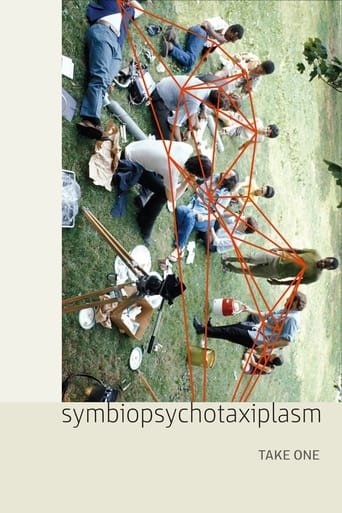whereismikeyfl
Symbiopsychotaxiplasm points the way toward so many later development in film. It manipulates reality by provoking the hapless cast, crew and bystanders to play roles by provoking them. The director of the film uses his own behavior as a Rorschach test. The whole genre of reality television as well as avant-garde documentary styles are anticipated in this film.In addition to its historical importance the film is fascinating on its own terms for anyone who likes to think about the nature of performance vs. reality. Gender, race, sexuality and the march of time also make appearances. Criterion has done its usual terrific job in rescuing this forgotten masterpiece from undeserved obscurity.
valis1949
In 1968 when, "SYMBIOPSYCHOTAXIPLASM: Take One", was released, it came from out of nowhere, and struck like a psychedelic thunder bolt. Afro-American actor and film maker, William Greaves, aimed to forever alter the 'news-reel' style of documentary film-making, and to this day, there has never been anything quite like it. The movie is a film about 'the making of a film', and intentionally written and directed so as to create as much controversy and contradiction as possible. Set in New York's Central Park, the action and scant dialog concern a couple who fight and bicker about homosexuality and abortion. The woman wants out of the relationship, and the man wants an explanation. Near the end of this interaction, a drunk homeless man interrupts the proceedings and offers his commentary, and personal back-story. Then, after the principle footage has been shot, the film crew add their own views of the film-maker and what they feel is his inept handling of the movie. And during the entire film, multiple cameras are employed to record the action within the scene, and extraneous commentary by cast, crew, and onlookers. I would certainly recommend this film to anyone who has an interest in Avant Garde film makers such as Andy Warhol, John Cassavetes, or Jim Jarmusch. William Greaves attempts to show that a thing cannot be truly observed and understood because the viewing itself would alter the reality. "SYMBIOPSYCHOTAXIPLASM: Take One" can be seen as a cinematic representation or application of The Uncertainty Principle. This is only one possible explanation, and Greave's true intent is certainly open for speculation. Above all else, this film seeks to confound, confront. and stimulate, and without a doubt, succeeds admirably.
Polaris_DiB
How important is the director, anyway? In this film, made in the politically tumultuous times of the late 60s where questions of social organization were prime conflicts, asks that question by making a movie that turns the camera away from the action and only begs to reveal the director, William Greaves. It is an important work, as it shows like no other movie shows the difficulties in blocking, organizing, and setting the scene; it reveals the role of the crew, something most directors frankly would like to disappear completely and that the invisibility of is essential for suspending disbelief; and it also puts into consideration the role of performance and scripting and how they match/don't match reality and what that has to say about how the director ultimately influences reality (if at all).The documentary, or pseudo-documentary, or fictional narrative (whichever you prefer, via your interpretations of the themes) has its brain in the over-educated, over-intellectual crew, its guts in the lost performers struggling to understand the vague and ambiguous directions, and its heart in the director, who stands in as the desire to portray, to represent, to express without any idea how to do any of those things or why he wants to do it. It's a film that purposefully repeats banalities just to see if they can become more than banalities. It's a film that sometimes shows the multiple shots simultaneously, just to leave the editing to the audience and also reveal how disturbingly different shots change perspective.It's an important work, and something that everyone interested in the industry and process of film-making should watch and understand. It, like many experimental films, has no real mass-audience appeal--it's not for them. It's for the industry, and its for the 60s, asking what to do with a group-effort medium that still relies on a single "voice" and "author".--PolarisDiB
tedg
This was recommended by a reader, and I'm glad to have seen it. But that's only because I'm interested in anything that contributes to the vocabulary of folding or self-reference. But I would not recommend this to you as a film experience. It is a clever idea: film acting students in Central Park doing a screen test. The lines they play with are capriciously malleable. Meanwhile a camera documents the events behind the first camera. There's sometimes a third camera as well, and from time to time that camera focuses on a discussion of the crew. They're discussing — with amazing vacuity — the advanced implications of the film.In other words it is explicitly self-referential in the simplest of ways. There are many more clever folds in the film world, and certainly from that period, so this isn't rare or even novel. It would be something to recommend if all this relatively sophomoric enlightenment had been turned to something that had blood and muscle of some kind.But it hasn't. Its one tool in a collection of several that have to be applied to the real building material of life. It lacks any of that and isn't a particularly sharp tool at that.Perhaps Part 2 1/2 will be worth it.Ted's Evaluation -- 2 of 3: Has some interesting elements.




